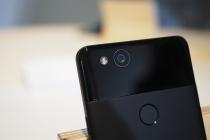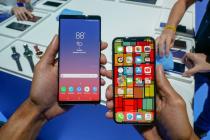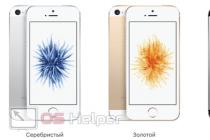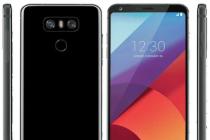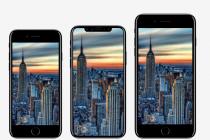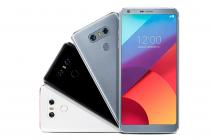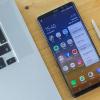Read the article: 4 712
How popular was it seven years ago when Samsung introduced the first Galaxy Note tablet? For the smartphone market, this is an eternity. Here, one failed device can be a real disaster. This happened two years ago with the Galaxy Note 7. Now it is in the past and Samsung is boldly proposing a new model.
Galaxy Note 9 can be called the first announcement of the upcoming holidays at the end of the year. This honor also means great responsibility. Samsung sets the bar ahead of its competitors. The Galaxy Note line has always been at its best, so it should be this time too.
However, the smartphone market is always changing. Their prices continue to rise, so the question of price-quality ratio is becoming more and more important. It is no longer enough to just offer a next-generation processor and increase storage to keep people buying the device.
Specifications (edit)
- Dimensions and Weight: 161.9 x 76.4 x 8.8mm, 201g
- Materials: glass, aluminum
- Biometrics: Fingerprint Scanner, Facial Recognition, Iris
- Protection: IP68
- Colors: black, blue, brown, purple
- OS: Android 8.1, Samsung Experience
- Screen: 6.4 inches Super AMOLED, 1440 x 2960, 516 ppi, 83.51%, HDR
- Cameras: 12MP rear, LED flash, f / 1.5 and f / 2.4, 1.4μm pixel size, 26mm focal length, 1 / 2.55-inch sensor, 2x optical zoom; second camera 12 megapixels, f / 2.4, viewing angle 45 degrees; phase detection autofocus; 4K 60 fps video, optical stabilization on both cameras. Front 8 MP.
- Processor: Snapdragon 845 8-core 64 bit, Kryo 385 2800 MHz, 10 nm, Adreno 630
- Memory: 6/8 GB, storage 128/256 GB, microSD up to 512 GB
- Battery: 4000mAh
Design
Samsung rarely changes the look of its smartphones almost completely. And this time it didn’t happen. The Galaxy Note 9 is almost indistinguishable from last year's Galaxy Note 8. You don't have to think that this is necessarily a bad thing. The previous device was very beautiful and of high quality, the new one is the same. It has a premium look, glass and metal with curved edges. A blue version of the device with a yellow stylus is being considered. Such a contrast is unusual and seems to be something new. Although stains and dirt collect on the glass, it is relatively easy to wipe off.





The dimensions of the device differ little from its predecessor. The smartphone has become a little wider and thicker. The location of the buttons and connectors has not changed. Thankfully, Samsung is listening to customer feedback and has moved the fingerprint scanner under the rear camera. Now it's easier to reach him.
The engineers paid close attention to detail. Smartphones these days are phasing out the headphone jack to make room for other components. The Galaxy Note 9 has a headphone jack. There is also heart rate monitoring, an iris scanner, two speakers, an S Pen stylus compartment and even wireless charging. IP68 water and dust protection is not forgotten.
S Pen
The Galaxy Note line wouldn't be it if it didn't include the S Pen. Special attention is paid to this accessory this year. The appearance does not differ from last year's. In the hands it feels like a real pencil or pen. Samsung has added new functionality to it. Support for the Bluetooth Low Energy communication standard has appeared, thanks to which the stylus can be used as a remote control. With it, you can take photos, scroll through the gallery and presentations, play videos and music.

All this is done without touching the smartphone screen. It will be interesting to see how third-party developers can use the stylus's capabilities. Samsung has released a development kit for them. The main purpose of the stylus remains in drawing and writing. If you have artistic talents, 4096 degrees of pressure can come in very handy.
Screen
The screen differs little from its predecessor. The Super AMOLED panel has grown 0.1 "to 6.4". The resolution is 1440 x 2960 pixels. Color temperature approx.6,400K, providing high color fidelity in the sRGB color range. These characteristics are almost identical, which means the highest quality.

Maximum brightness increased to 575 nits in Adaptive display mode. The screen is still very eye-catching thanks to its high details, rich colors, wide viewing angles and deep blacks. In the video boost mode, the picture becomes even more attractive, as well as when watching HDR videos on YouTube.
Curvature on the sides of the screen has long been a hallmark of Samsung's flagship smartphones. In this regard, there is nothing new here. The side panels still provide quick access to various smartphone actions.
Interface
There is nothing special to say here, since everything remains the same. The handset runs Android 8.1, although it would be really nice to see Android Pie here. The system is already rolling out to Google Pixel smartphones, and Samsung would get a lot of gratitude from users if it released a device on it. The Samsung Experience shell on top of Android is no different from what is on the S9 +. The interface has a minimalistic look. In Samsung's tradition, there are many additional functionalities for advanced users. The smartphone can do more than other Android models, because it is aimed primarily at work.





The S Pen stylus contributes somewhat to the differentiation of the Android interface from other smartphones. It can come in very handy when you have to sign a PDF document, mark up the margins of a site, write a note on the screen, etc. The Bixby assistant has been updated and its functionality is gradually expanding. In particular, he is getting better at understanding voice commands.
To turn a smartphone into a computer, there is no need to buy. Now you just need to use a regular USB-C> HDMI cable to access your desktop. In Russia, you need to pay about 7,000 rubles for this docking station, so saving this amount will be very useful. Now you just connect your smartphone to the monitor and keyboard with a cable and it starts working like a computer.
Samsung has made some changes to AR Emoji, but this functionality is still child's play. She may look interesting in the first two minutes, but then it gets boring.
In general, in terms of the interface, the Galaxy Note 9 does not bring anything revolutionary compared to the Galaxy Note 8. However, you should not break what is not broken. No other smartphone has this level of practicality to operate. With the help of the stylus, the functionality has become even wider.
Performance and memory
Naturally, the new smartphone gets the latest hardware components. In the Russian version, the processor Samsung Exynos 9810 will be used, in the USA the Snapdragon 845 will be used. The review considers the version with 6/128 GB of memory. The device works seamlessly with applications, and with many at once. Its responsiveness is at the level of other modern flagships, that is, it reacts to user actions very quickly.

In terms of gaming capabilities, this device does not disappoint either. He copes with any modern mobile games without difficulty. Benchmarks show a favorable picture. In real games, you will get high frame rates and smooth operation. In many ways, thanks for this is the new liquid cooling system. Despite this, even it will not save the case from heating if you play for a long time.
The storage capacity has grown from the previous 64 GB. In addition, you can install a memory card up to 512 GB. The second version of the smartphone has memory configurations of 8/512 GB. Thus, the storage capacity on this smartphone can be up to 1 TB. Surely you have seen few computers with a similar value, but here you can carry so much data in your pocket.
Cameras
Smartphones often get the same cameras as their predecessors, with minor enhancements. This is the case with the Galaxy Note 9. Once again, a dual camera is used here, as in the Galaxy Note 8. In addition, there is a variable aperture, as in the Galaxy S9. As a result, the combination is the same as on the model. The main camera is a wide-angle 12 megapixel with optical image stabilization and an aperture of f / 2.4 and f / 1.5. The latter value is intended to improve the quality of low-light shots. The second camera has telephoto lenses with 2x zoom and also has optical image stabilization. This will avoid shaking when holding the device in your hands.

The camera is operated in the same way as on the Galaxy S9 +. There are different shooting modes such as panorama, hyperlapse, slow motion, live focus, professional mode with manual settings. The only new feature is scene optimization, where there are 20 different options. When the camera selects one of them, it changes the settings. If you don't like the result, you can turn off this mode.
Image quality
We can say that the photos are stunning. Whether you are a frequent social media user or a mobile photography enthusiast, the Galaxy Note 9 is suitable for a wide variety of shooting scenarios. The device perfectly shoots on bright sunny days, providing a wide dynamic range and the highest clarity. Even without Live Focus, the natural level of bokeh is impressive.





When the lighting isn't the best, the variable aperture comes into play and the shots are good too. The camera performs well even with high contrast. Shadow detail is preserved, and highlights are muted enough to produce a neutral exposure. When there is very little light, the aperture becomes f / 1.5 and the shutter speed slows down to collect more light. Many smartphones have had trouble in these conditions and the photos would have been blurry, but on the Note 9, stabilization does the job. The details may not be as sharp, but the photos are acceptable.
The front camera has a resolution of 8 megapixels, as in the Galaxy S9 and S9 +. The detail is also good here, there are wide-angle lenses. This is more than enough not only for capturing the face, but the whole person at arm's length. There is also a background blur mode here, but too aggressive. It often blurs the face instead of the background. The quality is not as high as on the Pixel 2.
Video quality
In terms of photography, everything is fine, in terms of video, it's not worse. The maximum recording resolution is 3840 x 2160 pixels at 60 fps. This means incredibly clear, detailed video.
Do not shoot at this speed in low light as the image is blurred and digital noise appears. In this situation, it is better to switch to 30 fps, the image will be of higher quality. The exposure will be improved, the detail will increase. Certain parameters can be controlled in professional shooting mode, but not all of them can be changed during shooting. For example, ISO remains fixed. I wish Samsung would offer a true manual video mode, as is the case with the LG V line of smartphones.
As in the case of the Galaxy S9, the new device has super slow motion video recording at 960 fps with 720p resolution. Interesting shots can be obtained here, but detail is washed out due to the low resolution and a high ISO value is required. Standard slow motion captures at 240 fps with 1080p resolution. There is no duration limit, so you don't have to try to guess exactly with the start time.
Multimedia
With dual speakers, one at the bottom next to USB-C and the other in the phone sink, users will experience stereo sound. The quality is good, the volume of 74.6 dB is not inferior to the Galaxy Note 8. There are smartphones with more powerful speakers, but here at least distortion and shrill sounds are imperceptible at maximum volume.

More and more smartphones are losing the headphone jack, but Samsung remains faithful to them for now. This makes one wonder why other developers are getting rid of them. The Galaxy Note 9 is a pretty sleek device, and the presence of a headphone jack does not prevent it from having many other functionalities. Usually, manufacturers, removing this connector, say that they are using the space inside the case for other purposes.
You also need to talk about watching videos on this smartphone. Thanks to the Super AMOLED screen, it comes out very rich and detailed. HDR is supported on YouTube for better viewing experience. A video enhancement function is available that increases brightness and contrast.
Call quality
Phone conversations on the Galaxy Note 9 won't be a problem. You will get pleasant sound, natural tones, and just enough volume to hear in noisy environments. There is a mode of additional volume, if required. However, the standard volume will probably be enough.
Also, the interlocutor will hear you without any problems. There is a hint of distortion, but not enough to negatively affect the conversation experience. The speakerphone pleased me, voices can be distinguished, the volume is high.
Autonomy
Samsung has tried to make the Galaxy Note 9 the longest-lasting smartphone in this lineup. The battery capacity has grown to 4000 mAh. Last year's Galaxy Note 8 only had a 3300mAh battery. Although it is difficult to notice by eye, the case thickness has increased slightly to make the battery fit inside. Hardly anyone will object to this.

In battery tests, the Galaxy Note 9 performed well. The battery life between charges with the screen on was 8 hours 56 minutes. This is an hour ahead of the Galaxy Note 8 and also ahead of the Galaxy S9 +. In everyday work, the smartphone will be able to last a full day even under heavy load. Usually by the evening about 35% of the charge remains.
The larger the battery capacity, the longer it takes to charge. In this case, not very long. It takes 109 minutes to charge from zero to 100%, not much more than the Galaxy Note 8. Wireless fast charging is available.
Conclusion
On the surface, there are several reasons why the Galaxy Note 9 is a fantastic smartphone. It produces sharp photos, it works for a long time without an outlet, one of the few offers a stylus. Few devices can match it in terms of functionality. However, it is the most expensive smartphone in the history of this line at a base price of $ 1000. In Russia, this means a price of 70,000 rubles. For most people, this will be the main factor against buying a smartphone. However, if you can afford it, the device is unlikely to disappoint you.

The Galaxy Note 9 has been improved in many ways over its predecessor. This still does not allow to call it a revolutionary device, as many hoped for. This is a pretty predictable evolutionary update. In almost all respects, he has become better, as it should be after a year. The stylus is better, and a better camera is offered, but if you have a Galaxy Note 8 there is little point in buying a new one. This is essentially the same Galaxy Note 8 in the same packaging.
If you have an older model, the transition to the Galaxy Note 9 should be good news. It can be safely recommended if you really need this kind of power and functionality. True, many of the features were borrowed from the Galaxy S9 + and are no longer surprising. In particular, the variable aperture dual camera is one example of this. However, the Galaxy Note 9 is in its own major league, where the number of players is very limited.
While various manufacturers are looking for excuses why they can't give this and that, the Galaxy Note 9 makes literally anything possible. We see that you can get a smartphone with phenomenal performance without losing the headphone jack. It also has an almost bezel-less screen without a cutout, a dual camera with a variable aperture, water resistance, a premium look and the ability to turn a smartphone into a computer. The Galaxy Note 9 lives up to expectations and makes the impossible possible.
pros
- Duration of work
- Great camera
- Base storage doubled
- Advanced S Pen capabilities
- Desktop without docking station
- Design
Minuses
- Minimal differences compared to Galaxy Note 8
If you have read this article to the end and you liked it, you can rate it. Also subscribe to our channel in

